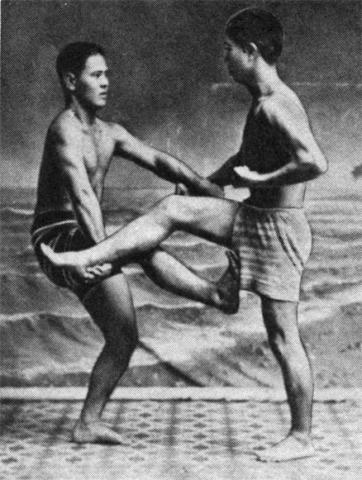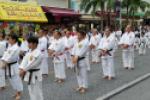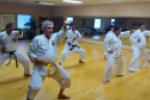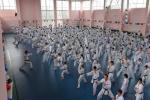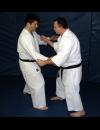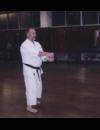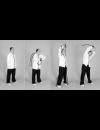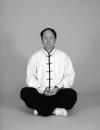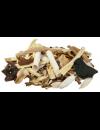Kumite’s Changed Role and Purpose in Sports Karate
March 4, 2024
These new techniques, footwork, steps, mindsets, strategies, tactics, and positions used in today’s sports-karate’s kumite illustrate best the discipline’s far-reaching separation from karate-jutsu’s kata: there is no kata anymore in sports-karate’s kumite.
7 Min. Read
Advanced Level of Knowledge and Understanding in Combat
February 19, 2024
Advanced level karateka understand concepts, including all their hidden options, and realize all the big pictures in combat where these concepts may be applied, whereas beginners narrowly see a technique to be used for only one specific application.
9 Min. Read
Okinawa is more than the Birthplace of Karate - Okinawa is a Mindset
December 4, 2023
Reflections from Dr. Hermann Bayer and his attendance at “Day of Karate” October 25, 2023 Naha, Okinawa, Japan.
Inductive vs. Deductive Learning in Karate
September 11, 2023
“It is a common fact―and mistake―that someone, who supposes his/her knowledge being insufficient, chooses to study “broadly,” i.e. to study another related subject, instead of deeper penetrating the subject at hand.”
Commercialization Turned Karate-Do Into a Commodity
August 21, 2023
In the early 1980s the unique selling position of Japanized Karate-Do (with Shotokan as its prototype) was well established and further initiatives focused on stabilizing its market position and its organizational structure which was remarkably successful in both preserving its Japanese identity and protecting copyrights and financial interests.
Karate Choices for Lifetime Achievements
-
June 13, 2012
In karate, when your sporting days are over, you might, like many others, make the false assumption that you can simply move across to budo karate: if you do, you’re making a big mistake!
Be Wary of Concussions
-
March 26, 2012
There were only two combatants involved, but it took eight of us to break up the fight without hurting anyone, four officers, three security guards, and myself. Once we got the participants separated we began sorting out what happened.
Sport, Health, and Martial Art: Kyogi, Kenko, and Budo
-
March 19, 2012
For many people training in karate these days, there seems to be only one way to train … their way! Like other martial arts, karate has not escaped the glare of commercialism, and with that, the packaging and branding of each school, style, or association.
Four Chokes and Cranks for Street Use
-
February 27, 2012
The type of chokes and cranks discussed here are designed for the street. Several of them have been banned from judo competition because they are too dangerous for sport.
Use Neck Cranks or Chokes to Fight an Adversary
-
January 9, 2012
In single combat, we can confuse the enemy by attacking with varied techniques when the chance arises. Feint a thrust or cut, or make the enemy think you are going to close with him, and when he is confused you can easily win.
Developing Fortitude and Fighting Strategies
-
November 22, 2011
Polishing the spirit (sen ren shin) is the term used to point the student of traditional karate toward the idea of developing fortitude. This is achieved through diligent training conducted frequently over a protracted period of time.
Ten Precepts of Karate
-
October 3, 2011
Truths abound. They are all around us like radio waves carrying music through the air; the trick is to discover how to tune into them. For over three and a half decades, I have been guilty of stumbling over more than a few truths.
Shin Gi Tai – Karate Training for Body, Mind, and Spirit
-
September 26, 2011
The dojo is a special place, where guts are fostered and superior human natures are bred through the ecstasy of sweating in hard work. The dojo is a sacred place, where the human spirit is polished. -Shoshin Nagamine sensei, Founder of the Matsubayashi ryu karatedo.
Shu-ha-ri - The Phases of Mastery in a Dojo and with a Pen
-
September 19, 2011
It’s not unusual for martial artists to talk solemnly about “the Way” and how the life lessons that have been created through training spill over into the rest of our lives.
Channeling Sekishusai
-
July 18, 2011
One of the most important aspects of martial arts training (and the thing that first attracted me to the activity) is the linkage between things of the body and things of the spirit. There’s a lot to be said for the physical aspects of training—and if most people are anything like me, it’s almost addictive.
Outdoor Martial Arts—A Guide to Training without Sunburning
-
July 11, 2011
The image of martial arts students training outdoors is pervasive. From Beijing parks to the Shaolin Temple, from Hollywood and Hong Kong movies to "Kung Fu Panda," the romance of outdoor training captures our imaginations. That attractive image may have some justification. Modern psychologists speak of the outdoors as a cure for "nature deprivation disorder."
Sanchin, Shime, and Hard Impact
-
July 4, 2011
At the conclusion of the examination, we gathered around the new Godan, and the finger imprints from the teachers slapping his shoulders resonated red and were buried deep in his sweat-covered skin.
Positive Attitude Required for Black Belt
-
May 30, 2011
Learning martial arts can be very challenging. It is a lifelong process that encompasses not only internalizing an abundance of fighting techniques, but also learning proper body alignment, breathing, and movement. It is both a physical and mental process.
The Meaning of 'Tradition’ in Traditional Karate
-
April 6, 2011
Much is written these days about traditional karate, but when it comes right down to it, what exactly is the "tradition"? It takes more than the wearing of a plain, white, karate gi (uniform) to make you a "traditional" karateka. A few bow's here and there and the use of a few Japanese words during training, won't do it either.
The Standing Eight Brocades Qigong: Exercises 1, 2 & 3
-
January 17, 2011
The standing set of the Eight Pieces of Brocade Qigong is more popular than the sitting set, so there are more versions of it. You should not worry about which version is better or more accurate, because the basic principles are the same.
The Sitting Eight Brocades: Exercises 1, 2 & 3
-
January 10, 2011
It has been nearly one thousand years since the Eight Pieces of Brocade were created. It does not matter which version you are training, the basic principles and theory are the same, and the goal is consistent. Remember that the most important thing in the training is not the forms themselves, but rather the theory and principle of each form, which constitute the root.
Coughs, Colds, Breathing Problems
-
January 3, 2011
The ability to breathe freely is crucial to the practice of the martial arts. Here are some combinations that can help with breathing problems due to a recent cold or hay fever. Note that a commonly accepted guideline for exercise during a cold or the flu is the “neck up or neck down rule.”
Comments on Hojo Undo from Okinawan Karate Masters
-
December 27, 2010
Since I began traveling to Okinawa in 1984, I have been privileged to meet many great karate teachers over the years. Some have had a worldwide following, while others have not, but the majority of them have had something in common—their sincere love for the fighting arts of their homeland and their willingness to share what they know.
Practice Any Time, Anywhere
-
November 1, 2010
Consistent daily training makes all the difference in achieving your rank. Because there is so much to learn and everything builds from kihon, it is important to make a commitment to try to learn something new about your martial art, no matter how small, every day.
Good Herbal Habits
-
October 11, 2010
Are you still reading, still thinking about trying herbs? Have you decided you’re willing to take responsibility for your own herb use? Here are some good herbal habits; habits that will help keep you safe.
